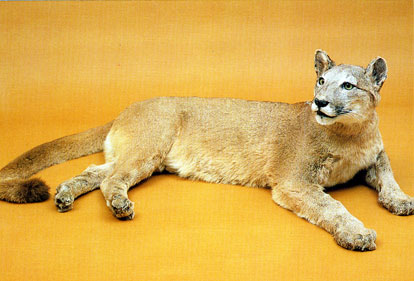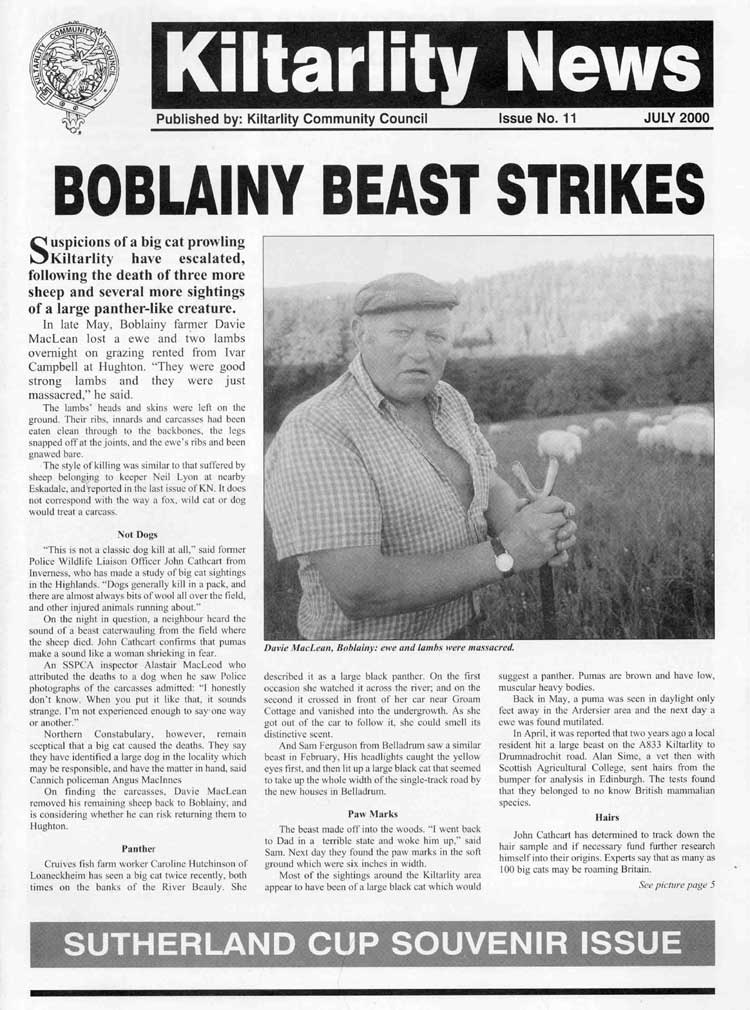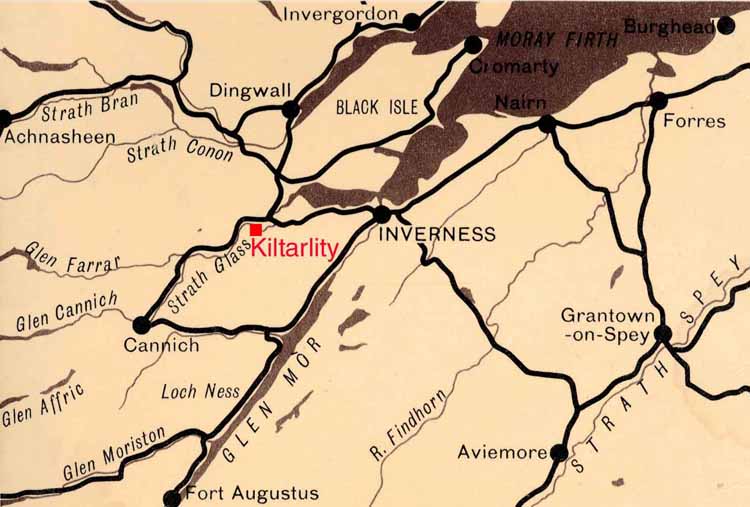
Photo Copyright (C) Inverness Museum & Art Gallery
Puma caught in 1980 at Cannich, and now on display
at
Inverness Museum & Art Gallery, Castle Wynd, Inverness.
There are well attested reports of "big cats" in the Highlands of Scotland, especially since the 1970's when the British laws relating to the keeping of "dangerous wild animals" were changed. It was very expensive to build acceptable cages for these cats, which had up to this point been "normal" domestic pets, and some owners, unable or unwilling to put a member of their family behind bars on a whim of government, tried to find alternative accommodation. They rapidly discovered that all zoos were over-supplied with large felines, and their pets faced the death penalty.
It is quite understandable that some owners decided to give their pets a chance of survival by releasing them into the wilds of Scotland where deer and rabbits cause untold damage to crops, and a little predation might not go astray. Indeed, there are still Government proposals to re-introduce wolves to the Highlands, where they were earlier exterminated in the 1600's.
Some animals were quite quickly recaptured, like the Puma caught in Cannich, not far from Loch Ness, by Mr Noble. Lack of sheep persuaded him that there was a predator about, and he constructed a cage trap to try to catch the culprit. He successfully caught a large female Puma, which despite an appetite for mutton also enjoyed having its belly tickled, and lived to a ripe old age at the Highland Wildlife Park in Kingussie, 30 km East of Loch Ness. When it finally died of old age it was stuffed and is now on display in the Inverness Museum, Castle Wynd, Inverness.
In recent years, less domesticated specimens have been seen on many occasions, and in 2000 alone there have been reliable sightings of "big cats", both brown and black versions, in many places around Loch Ness and Inverness, one as recent as July 22nd.
The sightings suggest a breeding population of at least one species, the Puma. These are usually brown, but black specimens are not uncommon, and they pose no threat to humans. Other possibilities are "black panthers" - actually black leopards* - and these are sometimes less innocuous. However, one would expect a mix of black and normal colouration in any natural population, and I am not aware of any reports of adult spotted specimens. Read more about them here.
* Everyone knows that a leopard cannot change its spots, but it can change the colour of the rest of its coat so that they become almost invisible!
Black "big cats" have been seen many times
around the village of Kiltarlity, a few miles from Loch Ness, where it
(they) have been called the Beast of Boblainy, after the locality where
they have been often seen.
I would like to thank Inverness Museum & Art Gallery for
permission to reproduce their postcard of "Felicity" the Puma, and recommend
all visitors to the Highland capital to view the excellent collections
and displays.
INVERNESS COURIER, TUESDAY, MAY 2, 2000
HIGHLAND farmers are being warned that prowling
big cats could threaten their stock during the lambing season.
The alert comes from former Northern Constabulary wildlife liaison
officer John Cathcart a, week after a puma was seen and a mutilated sheep
was later found in the Ardersier area.
"It was a particularly good sighting - in daylight, at a matter of
a few feet - of an animal that was positively identified as a puma," said
Mr Cathcart. "The witness owns 40-kilo dogs and he estimated this thing
was heavier than his dogs. Then the next day there was one sheep found
dead in the area. The lamb was still alive, but the mother was just in
bits."
The Ardersier sighting comes as residents of another Highland area
have been alerted to the possibility of big cats on the prowl. The latest
issue of the Kiltarlity Community Council newsletter, Kiltarlity News,
reports a string of livestock attacks by a mysterious beast in the area
over the past two years, including the loss of more than 20 sheep by Eskadale
keeper Neil Lyon.
Mr Catheart, who has investigated several reports of big cat sightings;
and kills, is certain that pumas or similar animals have established themselves
in the Highlands, putting lambs and other livestock at risk.
"Lots of lambs have been taken," he claimed. "There's one farmer in
the Dalcross area who lost 26 lambs last year, and I'm talking about lambs
that were taken away completely without any trace."
However, despite the long series of sightings, Mr Cathcart says the
public remain reluctant to believe in big cats roaming free in the Highlands.
"You get wee pockets of belief, but generally it's been Loch Ness monsterised.
But there is absolutely no doubt in my mind that there are a number of
animals in the Highlands and even going down to Argyll and then Aberdeenshire,"
he said.
"My personal view is that there is a breeding population. I have one
sighting from Daviot of a lioness and three cubs. I spoke to the chap himself
and he thought it was a lion, but I will contend it was a puma.
I think that if it had been a lion, we would have known all about it
by now! A puma would give the same silhouette as a lioness, so 1 would
say yes, they are certainly breeding."
Mr Lyon believes his sheep were victims of a big cat between October
1998 and the spring of 1999 when the mysterious attacks took place.
"My sheep were definitely not attacked by a fox or dog," he said. "These
sheep were one-year-old hoggs, they weren't small lambs and John Cathcart
was saying the way
they had been skinned was typical of big cats."
However, Mr Lyon believes that the culprit may have had its comeuppance.
A local driver collided with a mystery animal between Kiltarlity and Drumnadrochit.
Hairs were sent off for analysis to Napier College in Edinburgh, where
experts concluded they belonged to an animal that was not native to Britain.
"Since then we haven't had any trouble, touch wood," said Mr Lyon.
However, Beverley Wilson of the National Farmers Union believes lambs
are more likely to fall victim to more mundane predators than pumas or
panthers, with dogs and foxes the prime suspects.
"Nine times out of 10 or more, if you have a sheep kill, it will be
a dog," she said.
"This is why we say when it's lambing time, please keep your dogs inside,
or at least know where they are. Even the friendliest Labrador can do a
tremendous amount of damage if it gets among sheep."
And as someone who used to live on Dartmoor, home of Britain's most
notorious big cat, the legendary Beast of Bodmin, Miss Wilson admitted
to taking claims about puma kills with a pinch of salt.
I would have to see it to believe it," she said.
(Reproduced courtesy of Inverness Courier)

